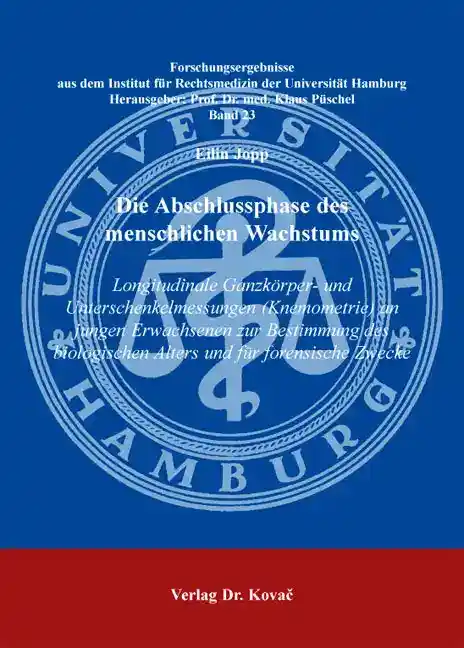Eilin JoppDie Abschlussphase des menschlichen Wachstums
Longitudinale Ganzkörper- und Unterschenkelmessungen (Knemometrie) an jungen Erwachsenen zur Bestimmung des biologischen Alters und für forensische Zwecke
Forschungsergebnisse aus dem Institut für Rechtsmedizin der Universität Hamburg, volume 23
Hamburg 2013, 236 pages
ISBN 978-3-8300-7184-6 (print) |ISBN 978-3-339-07184-2 (eBook)
About this book deutschenglish
The focus of this study was firstly to update the data bases for the closure of the proximal tibial epiphysis and other body measurements for the investigation of biological questions about tempo and amplitude of late adolescent males and secondly, the development of a non-invasive method for forensic age determination in living (Knemometrie and MRI). The weekly data were collected on a sample consisting of 41 young male subjects (15 – 19 years of age) from Hamburg and Schleswig-Holstein over a period of one year. The measurements of the lower leg length were accomplished with a newly developed hand-held knemometer (SD 0.3 mm). It has been shown that the adolescent final period of tibial growth is accompanied by a knemometric documented process of shrinkage. As shown in the MRI, when the proximal tibial growth plates have fused, the lower leg of healthy adolescent males begins to shrink with a significant negative growth rate of -2.4 (SD 2.1) mm/year. A phase of longitudinal shrinkage in the length of long bones at the end of growth has not been discussed as part of the physiological growth process yet. Given the results it is believed that a compression of still non-mineralized portions of the closing physis represents a physiological event during the final period of growth in adolescents. The state of maturity of the right proximal tibial epiphyses of each subject was determined by magnetic resonance imaging (MRI, at inclusion in the study and one year later). According to the degree of maturity of the epiphysis the growth plates were categorized as being open (category I), centrally but not completely fused (category II), or completely fused (category III). The images were categorized (I: open, II: closed center, III: closed). The developed evaluation scheme was used by six investigators. The calculated Interobserver reliability (Fleiss kappa index) with κ = 0.9 showed a high degree of compliance. The results suggest that the proximal tibial epiphysis in young men aged 15 to 19 years old is actively ossifying. In most cases this process is complete by the end of the 18th year of life. These results offer after detailed validation studies a new method of a non-invasive age estimation in living persons The research results have besides the anthropological basic scientific knowledge about human growth particular significance for forensic age estimation in living.Kontaktmöglichkeit
Keywords
Altersbestimmung bei LebendenBiologieForensische AnthropologieKnemometrieMethodenstudieMRTNichtinvasivRechtsmedizinSkelettaltersbestimmungUnterschenkellängeWachstumIhr Werk im Verlag Dr. Kovač

Möchten Sie Ihre wissenschaftliche Arbeit publizieren? Erfahren Sie mehr über unsere günstigen Konditionen und unseren Service für Autorinnen und Autoren.
